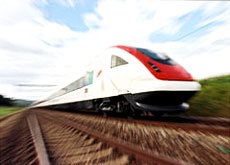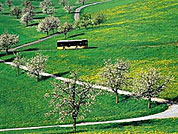Transport

Networks
Although many Swiss are car fanatics, they use rail transport more often than anyone else except possibly the Japanese, and public transport infrastructure covers the country.
There are now close to four million cars in a population of slightly more than seven million. At the same time, the average Swiss makes 47 train trips a year.
Switzerland has one of the densest rail networks in the world, most of it operated by the Swiss Federal Railways, which has been nationalised since the early part of the 20th century.
In addition, there are many mostly narrow gauge private companies operating regional and local services. Cantonal and local authorities are usually shareholders.
In mountainous areas there are countless funiculars, cog railways, and cable cars to the highest summits.
Goods traffic
Swiss transport policy wants to get freight traffic off the roads and onto the railway – largely for ecological reasons. This applies in particular to transalpine traffic between northern and southern Europe.
The existing Gotthard and Lötschberg lines have been undergoing reconstruction at lower altitudes, resulting in new 57- and 35-kilometre-long tunnels permitting high speed passenger and goods trains. The Gotthard should be completed by 2019, while the Lötschberg was opened in 2007.
Switzerland’s early participation in the “rail fever” of the mid 19th century means many rail lines meander between villages rather than forming direct links between cities.
Bus lines, often operated or subcontracted by the Swiss Post, assure transport where there are no rail lines. Competition is avoided as, in many cases, services are partly subsidised.
Many of these lines are however under threat, especially in rural areas, as cantonal governments cut subsidies to reduce their own spending.
Scheduled boat services operate on many lakes and rivers. While most passengers are tourists, there is a busy commuter link on Lake Geneva between Evian in France and Lausanne in Switzerland. And there is a popular car ferry between Switzerland and Germany on Lake Constance.
Bridges
The mountainous topography of Switzerland calls for an above-average number of bridges on road and rail routes, so it is not surprising that bridges in the old days had mythical connotations.
The so-called Devil’s Bridge near Andermatt on the Gotthard pass received that name because myth has it that the Devil demanded a living sacrifice if travellers were to cross the awesome bridge unscathed. According to legend, the canny locals first sent a little goat across the bridge on its completion.
Be that as it may, Switzerland’s road and rail network has some remarkable designs. Driving over the Gotthard motorway gives one little impression of the civil engineering work involved.
The reinforced concrete spans have a long history in this country. The Swiss Federal Railways’ Lorraine bridge in Bern, completed in 1944, was for many years the longest single-span concrete bridge in the world (151 metres).
Switzerland’s best-known bridge builder was Othmar Ammann of Feuerthalen near Schaffhausen. He was for many years chief engineer of the Port Authority in New York, and designed bridges over the Hudson, including the George Washington bridge, as well as the striking Verrazano Narrows suspension bridge, which is almost as long as the Golden Gate bridge in San Francisco.
Tunnels
The Alps have always been a barrier to road and rail links. Tortuous passages were inevitably closed in winter by snow. But the advent of railways and new tunnelling techniques in the second half of the nineteenth century ended the role of mountains as insurmountable obstacles.
The pioneering Gotthard rail line, with its twisting route, steep gradients, and a sixteen-kilometre tunnel under the pass of the same name was opened in 1882. Many other tunnels through the Alps followed.
In 1902 the Albula tunnel opened the way for the Rhaetian railway line from Chur in the Rhine valley to the budding winter resort of St Moritz.
In 1906, the first trains used the Simplon tunnel, which stretches almost 20 kilometres under the Swiss-Italian frontier. Swiss Federal Railways still operate the line from Brig in Switzerland to Domodossola in Italy.
The 15-kilometre Lötschberg tunnel, the Simplon’s twin brother, in the Bernese Oberland was completed just before the First World War.
From the 1960s onwards, motorways usurped public interest, and funding, from the railways.
1982 marked the opening of the 16.9-kilometre Gotthard road tunnel, for many years the longest in the world. It was preceded by other transalpine tunnels under the Great St Bernard and San Bernardino passes. These became all-year routes.
With the motorway network almost complete, new projects are restricted to triplicating tunnels at bottlenecks. Additional lanes at the most famous bottleneck of them all, the Gotthard road tunnel, seem unlikely now, though.
The 1990s saw the completion of the Vereina rail tunnel, opening a winter link between the Engadine valley and the lowlands.
The alpine tunnels are part of the European high-speed train network, significantly reducing journey times between cities in northern Europe and Italy. The first trains began using the new Lötschberg line in 2007, and the new Gotthard tunnel is due to open in 2017.

In compliance with the JTI standards
More: SWI swissinfo.ch certified by the Journalism Trust Initiative

You can find an overview of ongoing debates with our journalists here. Please join us!
If you want to start a conversation about a topic raised in this article or want to report factual errors, email us at english@swissinfo.ch.